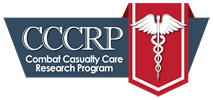CBRN Combined Injury & Radiation Health Effects
U.S. Forces will require capabilities to enable and sustain multi-domain operations against a variety of threats from peer and near-peer competitors. Impacts of the future operational environment on the Military Health System include high casualty numbers in a short period of time in armed conflict. The potential adversarial employment of chemical biological radiological and nuclear (CBRN) weapons will continue to require detection, identification and diagnosis, protection, treatment, and evacuation during and post incidents. Managing mass quantities of casualties with blast and burn injuries will consume significant equipment and resources, and the incapacitating and damaging physical effects of intense sound and light will increase hearing and eye injuries. Managing injuries will be more complex when combined with CBRN injuries.
The Combined Injury Portfolio aims to develop solutions related to modeling, triage, diagnosis, patient management and treatment for injuries combining trauma with CBRN exposures. The portfolio also focuses on the development of medical countermeasures (MCMs) for acute radiation syndrome (ARS) that will provide the Joint Force with safe and effective prophylaxis and therapeutics to increase survival, decrease morbidity, and enable continued operations during Joint All Domain Operations.
Combined Injury (CBRN Polytrauma)
Combined Injury, or CBRN polytrauma, is the occurrence of more than one physical injury. One of the injuries is caused by exposure to CBRN weapons. The other injury(ies) may result from traumatic brain injury, burns, blast wave, blunt or penetrating force, or other unspecified trauma.
The goal of this effort is to develop and transition emerging technology to enable combined injury care during prolonged field care scenarios and in austere/ remote, resource limited environments during Joint All Domain Operations.
CBRN research aims will address interactions of CBRN weapons exposure with other traumatic injuries. Additionally, research will advance the state of the science for current and emerging technologies to optimize triage, diagnosis, patient management and treatment for CBRN polytrauma.
Radiation Health Effects
The Radiation Health Effects research portfolio seeks to develop pre-exposure prophylaxes and post-exposure therapeutics to protect against and mitigate the potentially lethal effects of acute ionizing radiation exposure. The countermeasures are being developed for use at Roles of Care 1 through 3, that is from individual (or small unit) care through care at field and fleet hospitals. Protective capabilities are being developed to address the requirements of FDA licensure such as efficacy and safety plus specific operational attributes including preferred route and method of administration.
The main research goal is to develop FDA-approved medical countermeasures for pre-exposure prophylaxis and post-exposure mitigation of acute radiation syndrome (ARS) and the multi-organ injuries associated with ionizing radiation exposure.
We partner with academia and industry to execute research and development. A key DoD laboratory partnering with the Radiation Health Effects portfolio is the Armed Forces Radiobiology Research Institute (AFRRI) ![]() . Additionally, we coordinate closely with interagency partners including:
. Additionally, we coordinate closely with interagency partners including:
